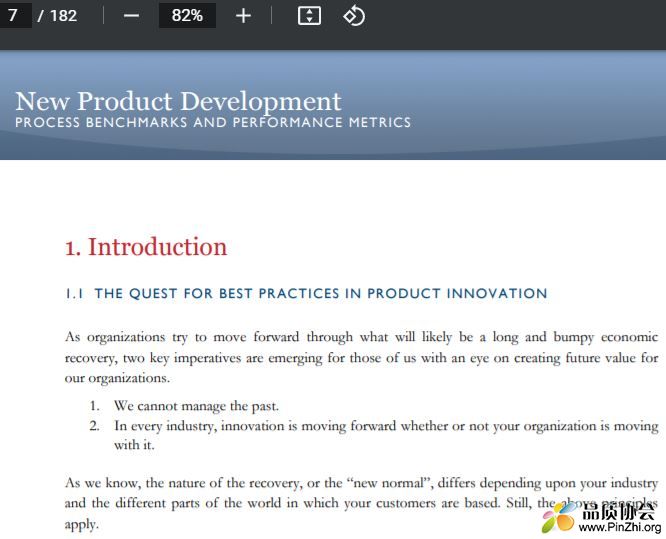APQC New Product Development PROCESS BENCHMARKS AND PERFORMANCE METRICS, 新产品开发流程标准和绩效指标EN版
APQC New Product Development PROCESS BENCHMARKS AND PERFORMANCE METRICS

Table of Contents
1. Introduction 7
1.1 The Quest for Best Practices in Product Innovation 7
1.2 The Key Research Questions 8
1.3 Topic Areas Studied 8
1.4 How the Benchmarking Research Was Undertaken 9
1.5 Organization of the Results 12
2. New Product Performance Metrics 13
2.1 Percentage of Revenues and Profits from New Products 13
2.2 Success, Fail and Kill Rates 14
2.3 Time to Market 16
2.4 On Time and On Budget 17
2.5 New Product Development (NPD) Projects Meeting Objectives 18
2.6 Business Entity Performance 20
2.7 Performance Metrics Used to Measure Project and NPD Program 21
2.8 Defining and Identifying the Top Performers 24
2.9 How the Best Versus Worst Businesses Fare in Terms of Performance Metrics 25
2.10 Types of New Products Developed 27
3. The Idea-to-Launch New Product Process and Practices 30
3.1 A Systematic New Product Process 30
3.2 Key Upfront Activities that are Built into the NPD Process 36
3.3 Gatekeeper Governance Practices 37
3.4 Quality of Your Gate Deliverables 40
3.5 Improving Your Gate Practices 42
4. The Impact of People 44
4.1 The Way NPD Project Teams are Organized and Lead 44
4.2 How to Handle Project Team Management 46
4.3 Senior Leadership Support 49
4.4 The Role of the Process Manager 50
5. Portfolio Management—A Special Insert 52
5.1 Portfolio Management 52
6. Conclusions and Recommendations 57
Appendices
A. In-Depth Case Studies
1. Air Products and Chemicals, Inc. 61
2. Ashland, Inc. 77
3. Becton, Dickinson and Company (BD) 90
4. Electro Scientific Industries, Inc. (ESI) 103
5. EXFO 114
B. Selected Data Charts
Section 1: Organizational Characteristics 138
Section 2: Governance 147
Section 3: Culture and People 150
Section 4: The NPD Process 153
Section 5: New Product Performance 168
Section 6: Tools and Systems to Support NPD 175
References and Endnotes 177
About the Author 179
About the Product Development Institute and APQC 180
Exhibits
1.1 The Sample—Industry Breakdown 11
1.2 Selected Characteristics of Businesses in the Sample 12
2.1 Percentage of Revenues & Profits from New Products 14
2.2 Success, Fail and Kill Rates—The Average Business 15
2.3 Success, Fail and Kill Rates—Top 25% vs. Bottom 25% 15
2.4 Time to Market (Idea to Launch Months) 16
2.5 Percent of Projects On Time, On Budget—Average Business 17
2.6 Projects On Time, On Budget—Top 25% vs. Bottom 25% 18
2.7 Percent of Projects Meeting Objectives 19
2.8 Additional Performance Metrics—The Average Business 20
2.9 How Businesses Fare in Terms of Performance Metrics 21
2.10 Key Measures Used to Define New Product Success or Failure 23
2.11 Key Indicators Used to Measure the Total New Product Program 24
2.12 Performance Metrics Results—The Best vs. Worst Performers 26
2.13 Performance Metrics—The Best vs. Worst Performers 27
2.14 Breakdown of Projects by Project Type for the Average Business 28
2.15 Breakdown of Projects by Project Type: Best 25% vs. Worst 25% of Performers 29
3.1 Whether Businesses Have a Systematic NPD Process in Place 32
3.2 Impact of Having a Systematic New Product Process in Place 34
3.3 How Business Performs on Critical Pre-Development Activities 37
3.4 Gatekeeping/Governance Approaches 38
3.5 How Effective are the Gates 40
3.6 Gate Deliverables 41
4.1 Primary Approach to Establishing Project Teams 45
4.2 NPD Project Team support—Best vs. Worst 46
4.3 Who Leads the New Product Development Teams 47
4.4 Senior Leadership Support—Best vs. Worst 49
4.5 Types of NPD Training Offered 50
5.1 How Businesses Fare on Portfolio Management 54
5.2 Impact of Portfolio Management—Best vs. Worst 54 |